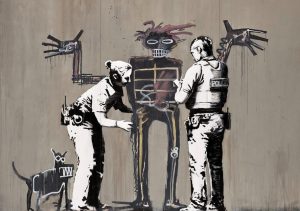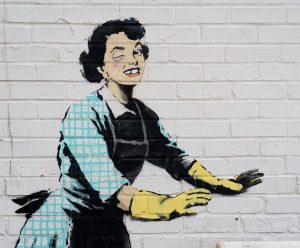M.V. Louise Michel
Mediterranean Sea, August 2020
www.mvlouisemichel.org

It might seem incredible there is need for a homemade emergency vehicle in one of Europe’s busiest waterways, but there is. In response to the crisis on the Mediterranean, European states instruct their Coastguard not to answer distress calls from ‘non-Europeans’ leaving desperate people to drift helplessly at sea. To make matters worse authorities prevent other boats from providing assistance, arresting crews and impounding boats that do.
In 2019, Banksy announced that he would finance a boat to rescue refugees attempting to reach Europe from North Africa. The vessel, Louise Michel, named after a French feminist anarchist, set off in secrecy on August 18 from the Spanish seaport of Burriana, near Valencia, and traveled to the central Mediterranean where it rescued 89 people in distress. Among those rescued were 14 women and 4 children. Approximately 350 people were saved in the first week alone by the Louise Michel – though the sad reality is that “saving their life at sea” and “finding safe harbor” are very different things. The Louise Michel tweeted seeking help from the EU as no country seemed willing to step up and offer safe harbor for the vessel.

Painted in bright pink with an extinguisher and featuring Banksy artwork depicting a girl in a life vest holding a heart-shaped safety buoy, the Louise Michel sails under a German flag. The 31-metre motor yacht, formerly owned by French customs authorities, is smaller but considerably faster than other NGO rescue vessels. It is estimated that more than 100,000 people attempted to make the journey across the Mediterranean in order to escape conflict and poverty in Africa and the Middle East, and more than 1,300 people died – though obviously there are no concrete numbers on this. Sadly, the numbers could be much, much higher.

The Louise Michel is a former French Navy boat we’ve customized to perform search and rescue. She is as agile as she is pink.
Measuring 30 meters in length and capable of over 28 knots, she was bought with proceeds from the sale of Banksy artwork who then decorated her with a fire extinguisher.
She is captained and crewed by a team of rescue professionals drawn from across Europe. She runs on a flat hierarchy and a vegan diet.

The Story Behind M.V. Louise Michel
The Guardian published the exclusive story on 27 August 2020
Read More
The British street artist Banksy has financed a boat to rescue refugees attempting to reach Europe from north Africa, the Guardian can reveal. The vessel, named Louise Michel after a French feminist anarchist, set off in secrecy on 18 August from the Spanish seaport of Burriana, near Valencia, and is now in the central Mediterranean where on Thursday it rescued 89 people in distress, including 14 women and four children. It is now looking for a safe seaport to disembark the passengers or to transfer them to a European coastguard vessel.

Banksy’s involvement in the rescue mission goes back to September 2019 when he sent an email to Pia Klemp, the former captain of several NGO boats that have rescued thousands of people over recent years.
“Hello Pia, I’ve read about your story in the papers.
You sound like a badass, I am an artist from the UK and I’ve made some work about the migrant crisis, obviously I can’t keep the money.
Could you use it to buy a new boat or something?
Please let me know. Well done.
Banksy.”

Klemp, who initially thought it was a joke, believes she was chosen by Banksy due to her political stance. “I don’t see sea rescue as a humanitarian action, but as part of an anti-fascist fight,” she told the Guardian.
She has made clear that Banksy’s involvement in the operations is limited to providing financial support. “Banksy won’t pretend that he knows better than us how to run a ship, and we won’t pretend to be artists.”
With a top speed of 27 knots, the Louise Michel would be able to “hopefully outrun the so-called Libyan coastguard before they get to boats with refugees and migrants and pull them back to the detention camps in Libya”, said Klemp.





